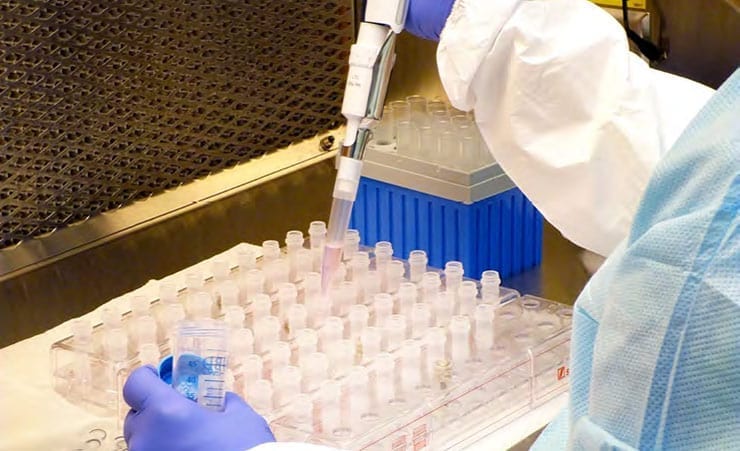The Naval Medical Research Center (NMRC) has been supporting DoD’s interagency efforts since the early months of the Ebola outbreak, which began in December 2013, when initial cases were reported in Guinea and later spread to Sierra Leone and Liberia.
A research team from NMRC’s Biological Defense Research Directorate (BDRD) has been busy producing more than 100,000 Ebola detection assays for the Medical Countermeasure System’s Critical Reagents Program (CRP), a part of the DoD Joint Project Management Office.
“We were tasked to produce assays when the outbreak began and as the crisis continues to worsen, our production tempo has increased dramatically. Our team is producing these assays every day,” said Dr. Joan Gebhardt, head of Molecular Diagnostics at BDRD.
Providing Important Biothreat Reagents
As part of its mission, BDRD produces reagents and detection assays for research and development in the DoD, U.S. agencies and other partners. These Ebola-specific assays are used in West Africa. Blood samples are being collected from patients exhibiting symptoms and tested to detect infection. These assays are used to confirm patients with probable or suspected Ebola virus disease so they can be moved to treatment centers; the assays are also used for screening potential contacts of infected individuals.
“This effort is a great example of what BDRD is capable of, quick rapid turnaround to provide detection assays for emerging infectious diseases anywhere on the globe,” said Cmdr. Guillermo Pimentel, Deputy Director of BDRD.
According to the Centers for Disease Control and Prevention‘s (CDC) website the first Ebola virus species was discovered in 1976 in what is now the Democratic Republic of the Congo near the Ebola River.
Since then, outbreaks have appeared sporadically. Ebola virus disease is characterized by fever, severe diarrhea, vomiting and can present as a severe viral hemorrhagic fever, an often fatal disease.
The disease is often spread through families and friends because they come in close contact when caring for ill persons. The disease can also spread quickly within clinics or hospitals in resource poor settings with limited infection control capabilities.
A Key Role in Protecting Military & Civilian Personnel
BDRD is focused on research and development to protect U.S. military personnel and civilians from the threat of infectious diseases and biological attacks.
The lab is certified as a National Laboratory within the CDC’s Laboratory Response Network for biological hazard testing and analysis. In addition, the production labs for molecular and immunological assays are under International Organization for Standardization ISO Guide 34/17025 accreditation.
The research team supports Naval Sea Systems Command ensuring Fleet protection, outfitting the Navy and Marine Corps with bioweapons defense field testing capabilities and managing the proficiency testing program for the Joint Biological Agent and Identification and Detection System platform.
Supporting the U.S. Government Health Security Agenda, the laboratory continues to expand their international research collaborations and programs.
Article and image courtesy of Naval Medical Research Center Public Affairs, edited for context and format.


